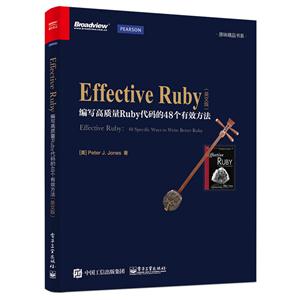序言前言致謝關于作者chapter 1: accustoming yourself to rubyitem 1: understand what ruby considers to be trueitem 2: treat all objects as if they could be nilitem 3: avoid ruby’s cryptic perlismsitem 4: be aware that constants are mutableitem 5: pay attention to run-time warningschapter 2: classes, objects, and modulesitem 6: know how ruby builds inheritance hierarchiesitem 7: be aware of the different behaviors of superitem 8: invoke super when initializing subclassesitem 9: be alert for ruby’s most vexing parseitem 10: prefer struct to hash for structured dataitem 11: create namespaces by nesting code in modulesitem 12: understand the different flavors of equalityitem 13: implement comparison via “<=>” and the comparable moduleitem 14: share private state through protected methodsitem 15: prefer class instance variables to class variableschapter 3: collectionsitem 16: duplicate collections passed as arguments before mutating themitem 17: use the array method to convert nil and scalar objects into arraysitem 18: consider set for efficient element inclusion checkingitem 19: know how to fold collections with reduceitem 20: consider using a default hash valueitem 21: prefer delegation to inheriting from collection classeschapter 4: exceptionsitem 22: prefer custom exceptions to raising stringsitem 23: rescue the most specific exception possibleitem 24: manage resources with blocks and ensureitem 25: exit ensure clauses by flowing off the enditem 26: bound retry attempts, vary their frequency, and keep an audit trailitem 27: prefer throw to raise for jumping out of scopechapter 5: metaprogrammingitem 28: familiarize yourself with module and class hooksitem 29: invoke super from within class hooksitem 30: prefer define_method to method_missingitem 31: know the difference between the variants of evalitem 32: consider alternatives to monkey patchingitem 33: invoke modified methods with alias chainingitem 34: consider supporting differences in proc arityitem 35: think carefully before using module prependingchapter 6: testingitem 36: familiarize yourself with minitest unit testingitem 37: familiarize yourself with minitest spec testingitem 38: simulate determinism with mock objectsitem 39: strive for effectively tested codechapter 7: tools and librariesitem 40: know how to work with ruby documentationitem 41: be aware of irb’s advanced featuresitem 42: manage gem dependencies with bundleritem 43: specify an upper bound for gem dependencieschapter 8: memory management and performanceitem 44: familiarize yourself with ruby’s garbage collectoritem 45: create resource safety nets with finalizersitem 46: be aware of ruby profiling toolsitem 47: avoid object literals in loopsitem 48: consider memoizing expensive computationsepilogueindex

















